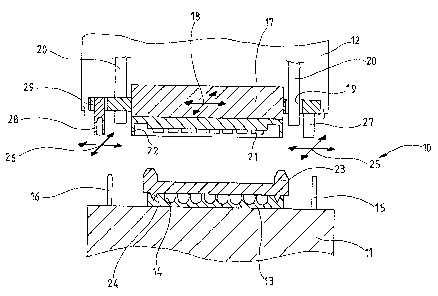Some of the information on this Web page has been provided by external sources. The Government of Canada is not responsible for the accuracy, reliability or currency of the information supplied by external sources. Users wishing to rely upon this information should consult directly with the source of the information. Content provided by external sources is not subject to official languages, privacy and accessibility requirements.
Any discrepancies in the text and image of the Claims and Abstract are due to differing posting times. Text of the Claims and Abstract are posted:
| (12) Patent Application: | (11) CA 2610729 |
|---|---|
| (54) English Title: | THERMOCYCLER |
| (54) French Title: | THERMOCYCLEUR |
| Status: | Deemed Abandoned and Beyond the Period of Reinstatement - Pending Response to Notice of Disregarded Communication |
| (51) International Patent Classification (IPC): |
|
|---|---|
| (72) Inventors : |
|
| (73) Owners : |
|
| (71) Applicants : |
|
| (74) Agent: | PERLEY-ROBERTSON, HILL & MCDOUGALL LLP |
| (74) Associate agent: | |
| (45) Issued: | |
| (86) PCT Filing Date: | 2006-03-04 |
| (87) Open to Public Inspection: | 2006-12-21 |
| Availability of licence: | N/A |
| Dedicated to the Public: | N/A |
| (25) Language of filing: | English |
| Patent Cooperation Treaty (PCT): | Yes |
|---|---|
| (86) PCT Filing Number: | PCT/EP2006/001995 |
| (87) International Publication Number: | EP2006001995 |
| (85) National Entry: | 2007-12-03 |
| (30) Application Priority Data: | ||||||
|---|---|---|---|---|---|---|
|
Thermocycler having a base body, which has a temperature-controllable
receiving region for reaction vessels, and having a lid which can be mounted
on the base body and can be brought, in the mounted state, from an open
position into a working position over the receiving region, wherein an optics
unit is arranged in the lid, wherein optics unit and/or receiving region are
received in the lid or base body with play, wherein the play permits a
relative movement sufficient for adjustment of the optics unit with respect to
the receiving region between optics unit and receiving region, and in each
case at least 2 positioning directions are provided on the base body and lid,
which permit a reproducible alignment of optics unit and receiving region in a
mutually adjusted position.
L'invention concerne un thermocycleur qui comprend un élément de base pourvu d'une zone de réception pouvant être tempérée pour des réacteurs et un couvercle, qui peut être placé sur l'élément de base et qui, étant monté, peut passer d'une position ouverte à une position de travail par l'intermédiaire de la zone de réception. Le couvercle est équipé d'une unité optique, cette unité optique et/ou la zone de réception étant logées avec un certain jeu dans le couvercle ou l'élément de base. Ce jeu permet un mouvement relatif suffisant entre l'unité optique et la zone de réception pour ajuster l'unité optique par rapport à la zone de réception. L'élément de base et le couvercle comprennent au moins deux dispositifs de positionnement qui permettent de reproduire l'orientation de l'unité optique par rapport à la zone de réception en une position d'ajustement mutuelle.
Note: Claims are shown in the official language in which they were submitted.
Note: Descriptions are shown in the official language in which they were submitted.

2024-08-01:As part of the Next Generation Patents (NGP) transition, the Canadian Patents Database (CPD) now contains a more detailed Event History, which replicates the Event Log of our new back-office solution.
Please note that "Inactive:" events refers to events no longer in use in our new back-office solution.
For a clearer understanding of the status of the application/patent presented on this page, the site Disclaimer , as well as the definitions for Patent , Event History , Maintenance Fee and Payment History should be consulted.
| Description | Date |
|---|---|
| Application Not Reinstated by Deadline | 2012-03-05 |
| Time Limit for Reversal Expired | 2012-03-05 |
| Inactive: Abandon-RFE+Late fee unpaid-Correspondence sent | 2011-03-04 |
| Deemed Abandoned - Failure to Respond to Maintenance Fee Notice | 2011-03-04 |
| Letter Sent | 2008-02-26 |
| Inactive: Cover page published | 2008-02-25 |
| Inactive: Notice - National entry - No RFE | 2008-02-21 |
| Inactive: First IPC assigned | 2007-12-22 |
| Application Received - PCT | 2007-12-21 |
| Inactive: Single transfer | 2007-12-13 |
| National Entry Requirements Determined Compliant | 2007-12-03 |
| National Entry Requirements Determined Compliant | 2007-12-03 |
| Application Published (Open to Public Inspection) | 2006-12-21 |
| Abandonment Date | Reason | Reinstatement Date |
|---|---|---|
| 2011-03-04 |
The last payment was received on 2009-12-29
Note : If the full payment has not been received on or before the date indicated, a further fee may be required which may be one of the following
Patent fees are adjusted on the 1st of January every year. The amounts above are the current amounts if received by December 31 of the current year.
Please refer to the CIPO
Patent Fees
web page to see all current fee amounts.
| Fee Type | Anniversary Year | Due Date | Paid Date |
|---|---|---|---|
| Basic national fee - standard | 2007-12-03 | ||
| Registration of a document | 2007-12-13 | ||
| MF (application, 2nd anniv.) - standard | 02 | 2008-03-04 | 2008-02-15 |
| MF (application, 3rd anniv.) - standard | 03 | 2009-03-04 | 2009-02-09 |
| MF (application, 4th anniv.) - standard | 04 | 2010-03-04 | 2009-12-29 |
Note: Records showing the ownership history in alphabetical order.
| Current Owners on Record |
|---|
| EPPENDORF AG |
| Past Owners on Record |
|---|
| BERND KRUGER |
| HENNER TASCH |